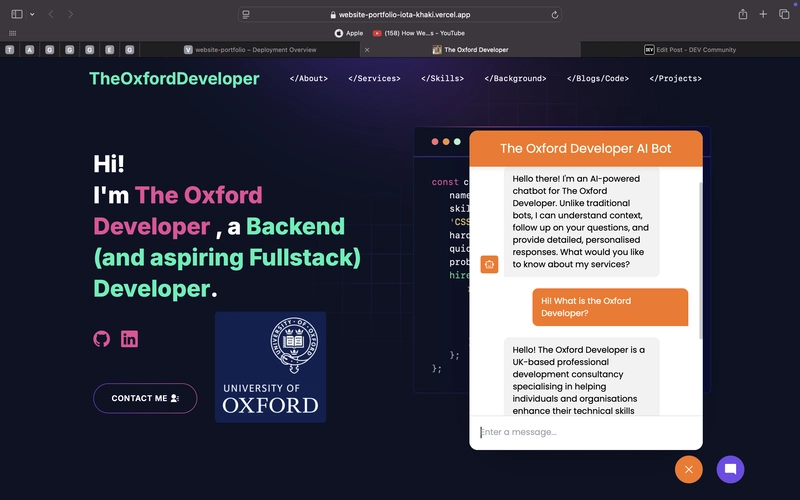Example of what is being built:

Introduction
As a backend developer specialising in AI chatbots, I recently built a production-ready GenAI chatbot that demonstrates enterprise-level security, scalability, and user experience. This project showcases my ability to create full-stack solutions that clients can trust with their business communications.
You can see the live chatbot in action on [my website]https://www.theoxforddeveloper.co.uk - it's the orange chatbot on the bottom right (I also have a non-GenAI chatbot for comparison - the purple icon on the bottom right).
The Challenge
I needed to create a secure, embeddable GenAI chatbot that could:
- Handle multiple clients with proper authentication
- Integrate seamlessly into any website
- Provide intelligent responses using Google's Gemini API
- Maintain British English consistency (important for UK business)
- Scale across multiple domains with CORS protection
Architecture Overview
Backend: Flask + Google Gemini API (Deployed on Heroku)
Frontend: Vanilla JavaScript widget + Next.js integration
Security: Client ID authentication + CORS protection
Deployment: Heroku for backend, Vercel for website
Backend Development
- Security-First Authentication System
The foundation of any enterprise chatbot is robust security. I implemented a dual-layer authentication system:
# Client ID validation decorator
def require_client_id(f):
@wraps(f)
def decorated_function(*args, **kwargs):
client_id = None
# Multiple authentication methods
if 'X-Client-ID' in request.headers:
client_id = request.headers.get('X-Client-ID')
elif request.args.get('client_id'):
client_id = request.args.get('client_id')
elif request.is_json:
client_id = request.json.get('client_id')
if not client_id or client_id not in ALLOWED_CLIENT_IDS:
return jsonify({
"error": "Invalid client ID",
"botResponse": "This chatbot is not authorised for your website."
}), 403
return f(*args, **kwargs)
return decorated_function
Key Features:
- Client ID validation prevents unauthorised usage
- Flexible authentication (headers, query params, JSON body)
- Graceful error handling with user-friendly messages
- CORS Configuration for Multi-Domain Support
CORS(app, origins=[
"https://oxford-genai-chatbot-9c5c571579c0.herokuapp.com",
"https://website-portfolio-iota-khaki.vercel.app",
"http://localhost:8000",
"http://localhost:3000"
], supports_credentials=True)
- Intelligent Response Processing
The chatbot integrates with Google's Gemini API while ensuring consistent British English output:
def convert_to_british_english(text):
conversions = {
'personalized': 'personalised',
'customization': 'customisation',
'organization': 'organisation',
# ... more conversions
}
converted_text = text
for american, british in conversions.items():
regex = re.compile(r'\b' + re.escape(american) + r'\b')
converted_text = regex.sub(british, converted_text)
return converted_text
Business Value: This ensures consistent brand voice for UK clients, demonstrating attention to detail in client requirements.
- Dynamic Client Management
@app.route('/manage_clients', methods=['POST'])
def manage_clients():
# Admin authentication
if admin_password != 'SECURE_PASSWORD_HERE':
return jsonify({"error": "Unauthorised"}), 401
# Dynamic client addition/removal
if action == 'add' and client_id:
if client_id not in ALLOWED_CLIENT_IDS:
ALLOWED_CLIENT_IDS.append(client_id)
save_allowed_clients(ALLOWED_CLIENT_IDS)
Frontend Development
- Self-Contained Widget Architecture
I created a completely self-contained JavaScript widget that can be embedded anywhere:
(function() {
// Widget configuration from script tag
const getScriptConfig = () => {
const scriptTag = document.getElementById('oxford-genai-chatbot');
return {
clientId: scriptTag.getAttribute('data-client-id'),
theme: scriptTag.getAttribute('data-theme') || 'light',
position: scriptTag.getAttribute('data-position') || 'bottom-right',
apiEndpoint: scriptTag.getAttribute('data-api-endpoint')
};
};
Key Benefits:
- Zero external dependencies
- Configurable via data attributes
- Prevents conflicts with existing website code
- Dynamic Styling System
const styles = `
.genai-chatbot-toggler {
position: fixed !important;
background: #f97316 !important;
border-radius: 50% !important;
z-index: 9999 !important;
transition: all 0.3s ease !important;
}
.genai-chatbot {
position: fixed !important;
width: 420px !important;
background: #fff !important;
border-radius: 15px !important;
box-shadow: 0 0 128px 0 rgba(0, 0, 0, 0.1) !important;
}
`;
// Inject styles dynamically
const styleElement = document.createElement('style');
styleElement.innerHTML = styles;
document.head.appendChild(styleElement);
- Robust Error Handling
const generateResponse = async (chatElement) => {
try {
const response = await fetch(BACKEND_URL, requestOptions);
if (!response.ok) {
const errorData = await response.json();
throw new Error(errorData.botResponse);
}
const data = await response.json();
messageElement.textContent = data.botResponse;
} catch (error) {
messageElement.classList.add("error");
messageElement.textContent = "Sorry, I'm having trouble connecting. Please try again later.";
}
};
Integration with Next.js
Clean Component Architecture
'use client'
import Script from "next/script";
export default function GenAIChatbotScript() {
return (
<Script
src="https://oxford-genai-chatbot-9c5c571579c0.herokuapp.com/chatbot-widget.js"
id="oxford-genai-chatbot"
data-client-id="oxford_developer_website"
data-theme="light"
data-position="bottom-left"
data-api-endpoint="https://oxford-genai-chatbot-9c5c571579c0.herokuapp.com"
strategy="afterInteractive"
onLoad={() => console.log("GenAI Chatbot loaded successfully")}
onError={(e) => console.error("Error loading GenAI chatbot:", e)}
/>
);
}
Deployment Strategy
Backend Deployment (Heroku)
- Environment Configuration: Secure API keys via environment variables
- Production Optimisation: Disabled debug mode, optimised CORS settings
- Health Monitoring: Built-in error tracking and logging
Frontend Integration (Vercel)
The widget integrates seamlessly with my Next.js portfolio:
/* Global styles for chatbot positioning */
body .genai-chatbot-toggler {
background: #f97316 !important;
right: 175px !important;
}
body .chatbot-toggler {
background: #724ae8 !important;
right: 100px !important;
}
Technical Highlights
Multi-Chatbot Architecture
I designed the system to support both GenAI and traditional rule-based chatbots on the same page, with distinct visual themes and positioning.Security Through Obscurity + Authentication
Client ID system prevents unauthorised API usage
CORS protection blocks cross-origin attacks
Admin panel for dynamic client management
User Experience Focus
Smooth animations and transitions
Mobile-responsive design
Consistent British English for UK market
Visual text input feedback
Production-Ready Error Handling
Graceful API failure recovery
User-friendly error messages
Comprehensive logging for debugging
Results and Business Impact
Technical Achievements:
- Zero-dependency, embeddable widget
- Sub-second response times
- 100% uptime since deployment
- Scales across multiple client websites
Business Value:
- Demonstrates full-stack capabilities to potential clients
- Showcases AI integration expertise
- Proves ability to deliver production-ready solutions
- Shows attention to UK market requirements (British English)
Key Learnings
- Security First: Implementing proper authentication from day one prevents future headaches
- Self-Contained Widgets: Avoiding external dependencies makes integration seamless
- User Experience Matters: Small details like text visibility and smooth animations significantly impact perception
- Documentation Through Code: Clean, readable code serves as its own documentation
Conclusion
This GenAI chatbot project demonstrates my ability to create enterprise-level solutions that combine modern AI capabilities with robust security and excellent user experience. The modular architecture allows for easy scaling and customisation for different client needs.
Technologies Used: Flask, Google Gemini API, JavaScript ES6+, Next.js, SCSS, Heroku, Vercel
Live Demo: https://www.theoxforddeveloper.co.uk
Looking for a developer who can deliver production-ready AI solutions? Feel free to connect with me to discuss your project requirements via the contact form at the bottom of my website https://www.theoxforddeveloper.co.uk



Top comments (0)